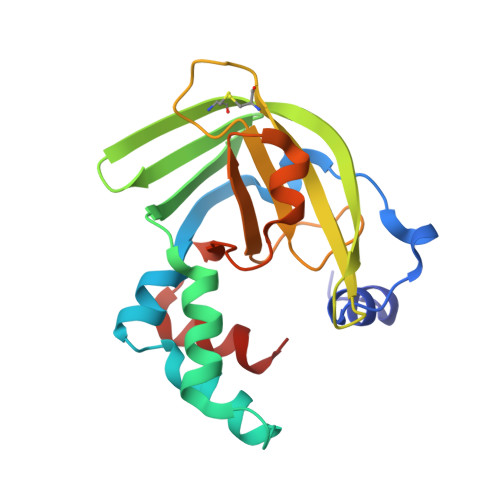The Salmonella Enterica Zint Structure, Zinc Affinity and Interaction with the High-Affinity Uptake Protein Znua Provide Insight Into the Management of Periplasmic Zinc.
Ilari, A., Alaleona, F., Tria, G., Petrarca, P., Battistoni, A., Zamparelli, C., Verzili, D., Falconi, M., Chiancone, E.(2014) Biochim Biophys Acta 1840: 535
- PubMed: 24128931
- DOI: https://doi.org/10.1016/j.bbagen.2013.10.010
- Primary Citation of Related Structures:
4ARH, 4AW8, 4AYH - PubMed Abstract:
In Gram-negative bacteria the ZnuABC transporter ensures adequate zinc import in Zn(II)-poor environments, like those encountered by pathogens within the infected host. Recently, the metal-binding protein ZinT was suggested to operate as an accessory component of ZnuABC in periplasmic zinc recruitment. Since ZinT is known to form a ZinT-ZnuA complex in the presence of Zn(II) it was proposed to transfer Zn(II) to ZnuA. The present work was undertaken to test this claim. ZinT and its structural relationship with ZnuA have been characterized by multiple biophysical techniques (X-ray crystallography, SAXS, analytical ultracentrifugation, fluorescence spectroscopy). The metal-free and metal-bound crystal structures of Salmonella enterica ZinT show one Zn(II) binding site and limited structural changes upon metal removal. Spectroscopic titrations with Zn(II) yield a KD value of 22±2nM for ZinT, while those with ZnuA point to one high affinity (KD<20nM) and one low affinity Zn(II) binding site (KD in the micromolar range). Sedimentation velocity experiments established that Zn(II)-bound ZinT interacts with ZnuA, whereas apo-ZinT does not. The model of the ZinT-ZnuA complex derived from small angle X-ray scattering experiments points to a disposition that favors metal transfer as the metal binding cavities of the two proteins face each other. ZinT acts as a Zn(II)-buffering protein that delivers Zn(II) to ZnuA. Knowledge of the ZinT-ZnuA relationship is crucial for understanding bacterial Zn(II) uptake.
- CNR Institute of Molecular Biology and Pathology and Department of Biochemical Sciences, "Sapienza" University of Rome, Piazzale A. Moro 5, 00185 Rome, Italy.
Organizational Affiliation:


















